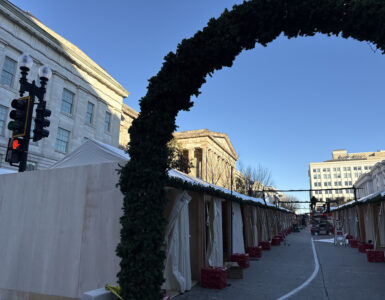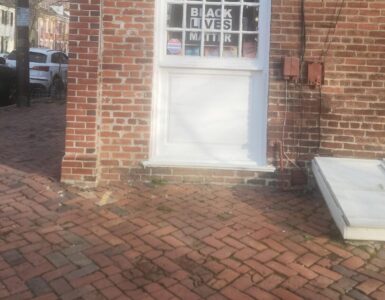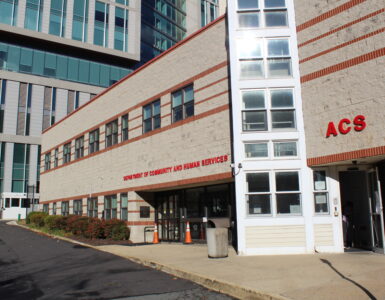An exhibit at Alexandria’s Torpedo Factory Art Center blends art and technology and invites visitors to rethink their digital lives and the hidden risks of an interconnected world.
In a unique fusion of technology and creativity, the Commonwealth Cyber Initiative is bringing cybersecurity to life through an exhibit that aims to change how visitors perceive the digital world around the
“I was blown away by how the artists made such a complex subject like cybersecurity feel so tangible,” said Fouad Medni, who visited who is visiting the exhibit. “It’s not every day you see something that makes you think deeply about what happens with your personal data,” Medni said.
The exhibit, funded by the Commonwealth, a statewide consortium of more than 40 universities and colleges across Virginia, features thought-provoking installations that delve into privacy, artificial intelligence (AI), misinformation, and surveillance themes.
This initiative combines the expertise of researchers and artists from institutions like Virginia Tech, George Mason University, and Old Dominion University to showcase projects that challenge people’s understanding of their relationship with digital technology.
This exhibit shows how the Internet of Things devices use artificial intelligence to create an image of us and how we can become invisible by using an invisible trigger, such as a sticky note, to activate a backdoor in the system.
Engaging with the Digital World’s Hidden Risks
After purchasing nearly 90 used phones from eBay, Michael McDermott, an assistant professor of graphic design at George Mason University, used a program called XRY to extract any available data.
He then meticulously reviewed the recovered files, selecting content from the phones’ previous owners to produce the videos.
An installation featuring 80 video displays in a wall full of phones confronts viewers with the reality of how easily their digital footprints can be exposed.
McDermott wants people to see themselves in the information presented from the phones as many don’t realize how much data remains on their devices, even after a reset.
Are you replacing your smartphone with a newer model? Remember to wipe it clean. “All those photos, texts, voicemails, and other personal information could end up in the wrong hands,” said a paper hanging on the wall near the phones.
Our emotions can be tracked
On another wall, Sentiment Voice, a project from Virginia Commonwealth University, explores how emotion-tracking AI is used to analyze facial expressions and vocal tones.
Typically employed for commercial purposes or surveillance, this technology is repurposed in the exhibit to share stories from Richmond’s immigrant communities through a live virtual reality performance.
The installation fosters empathy between performers and audiences by blending virtual and real-world experiences.
Medni, who is an Alexandria resident, was especially moved by Sentiment Voice, saying, “It made me realize how easily our emotions can be tracked and interpreted by AI”. The exabit made him think about the potential for both harm and connection in these technologies.
Art reflecting digital concerns
Virginia Tech’s installation uses the concept of steganography—hiding information within digital media. While no real data is hidden within the exhibit, the artwork explores the potential for concealing sensitive information within images and sound.
The installation features dancer Davian Robinson and the Gregory Guard, Virginia Tech’s silent drill team, alongside visual elements inspired by the Amazon rainforest and advanced sound technology.
The exhibit also tackles the issue of online misinformation by designing next-generation security warnings to mitigate social media misinformation.
The team behind this installation from James Madison University developed new warning systems for social media, using eye-tracking and brainwave-scanning technology to ensure that users notice and respond to alerts about misinformation.
The organizers hope the exhibit will inspire future cybersecurity professionals while offering a new perspective.
Bringing cybersecurity issues to the public
The exhibit also features interactive installations like Unveiling Invisible Sight from Old Dominion University. As Rui Ning, an Assistant Professor in the Department of Computer Science at Old Dominion University, told The Wash, “The project is about unveiling how IoT devices, like smartphones and smart cameras, see us from their perspective.”
Ning highlights that their research demonstrates how these devices collect various inputs to generate images that represent how they perceive humans.
Beyond showcasing this perspective, the project delves into the risks of AI manipulation. “We also created a backdoor in the AI model, which uses a trigger—like a pink sticky note—so when it is presented in front of the camera, the generated image will make it disappear,” Ning explains.
He adds that the message is clear: while AI models are powerful in recognizing faces and processing data, “they are also very dangerous and can be easily fooled by such a backdoor trigger.”
Visitors can interact with AI-generated avatars and learn about countermeasures that protect their data in a world of interconnected technology.
Ning hopes to convey to the audience that while “a model is very useful and interesting… it is also very dangerous,” urging caution when using AI for security-critical applications.
In addition to tech-driven projects, the exhibit offers Performances to reduce online scams, a Virginia Tech initiative aimed at helping older adults avoid online scams through interactive theater.
This project collects data directly from seniors and turns their experiences into a play, offering a unique way to educate the public about digital safety.
Reflecting on the exhibit, Medni said that he had never considered cybersecurity this way before. “It’s usually something you read about in the news or hear from experts, but seeing it through art made it feel more personal and real.”
From a Torpedo factory to the art center
The exabit is hosted by The Torpedo Factory Art Center, which began as a World War I-era munitions plant before evolving into a bustling art hub in Old Town Alexandria, housing more than 80 studios and galleries.
“The Torpedo Factory will be a place where visitors can see a diversity of art that reflects our evolving digital world,” said France Brou, who works for the center.
Brou said the Torpido factory has been working with a team of professors and students from Virginia “for about a year now, and they’ve been exhibiting different kinds of arts.”















Add comment